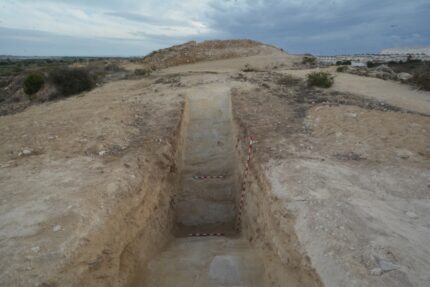Archaeologists have discovered the remains of an ancient moat at the Phoenician site of Cabezo Pequeño del Estaño in the southeastern coast of Spain. The moat is about 10 feet deep and 26 feet wide at the top and was part of the defensive systems of the 8th century B.C. Phoenician citadel. It is the only Phoenician moat from its age known to exist in the western Mediterranean. The only other comparable structures are in Phoenician cities like Tel Dor, Israel, and Beirut, Lebanon.
The site was founded in the 8th century B.C. by Phoenician merchants who traveled from the Mediterranean up the Segura River. They built a citadel on the banks of the river in around 770-750 B.C., following a well-planned urban template seen in other Phoenician colonies. Excavation of the settlement area has revealed the presence of commercial concerns — storage structures, warehouses, metallurgic workshops, forges, furnaces — and residences — a large roundhouse with adobe benches, other dwellings.
A multi-disciplinary team from the University Institute for Research in Archeology and Historical Heritage (INAPH) of the University of Alicante and the Archaeological Museum of Guardamar (MAG) have been excavating the site since 2013, focusing on getting a wide picture of the defensive structures, long obscured by sedimentary deposits, natural erosion and damage wrought by a quarry that destroyed much of the town in the 1990s.
Aerial photography first detected evidence of a moat running parallel to the citadel wall. This year’s excavation confirmed it was indeed a defensive moat, painstakingly cut out of the living rock by hand. Chisel marks are clearly visible in the substrate.
This exceptional find confirms the challenges encountered by Phoenician settlers on the Iberian coast. They encountered enough hostility from the locals to justify the massive effort expended in carving out and building a heavily fortified settlement at Cabezo Pequeño del Estaño. The natural resources of the area, primarily metal mining (Cabezo Pequeño del Estaño means Little Head of Tin) made it worth their while. For a few decades, at least. The town was abandoned around 700 B.C.
